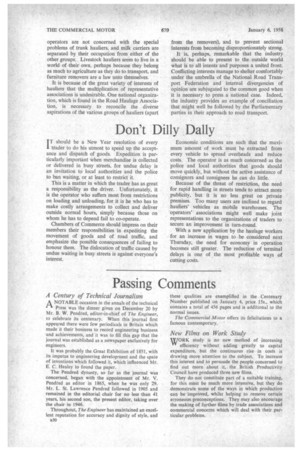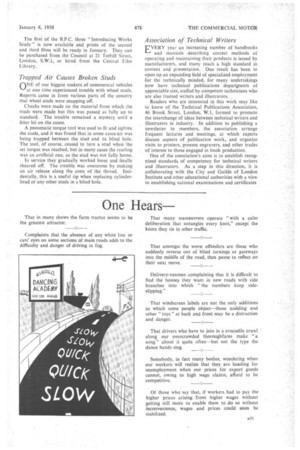Passing Comments
Page 38

Page 39

If you've noticed an error in this article please click here to report it so we can fix it.
A Century of Technical Journalism
ANOTABLE occasion in the annals of the technical
. Press was the dinner given on December 20 by Mr. B. W. Pendred, editor-in-chief of The Engineer, to celebrate its centenary. When this journal first appeared there were few periodicals in Britain which made it their business to record engineering business and achievements, and it was to fill this gap that the journal was established as a newspaper exclusively for engineers.
It was probably the Great Exhibition of 1851, with its impetus to engineering development and the spate of inventions which followed it, which influenced Mr. E. C. Healey to found the paper.
The Pendred dynasty, so far as the journal was concerned, began with the appointment of Mr. V. Pendred as editor in 1865, when he was only 29. Mr. L. St. Lawrence Pendred followed in 1905 and remained in the editorial chair for no less than 41 years, his second son, the present editor, taking over the chair in 1946.
Throughout, The Engineer has maintained an excellent reputation for accuracy and dignity of style, and B30
these qualities are exemplified in the Centenary Number published on January 4, price I5s., which contains a total of 456 pages and is additional to the normal issues.
The Commercial Motor offers its felicitations to a famous contemporary. '
Nev Films on Work Study
woRK study is no new method of increasing " efficiency without adding greatly to capital expenditure, but the continuous rise in costs is drawing more attention to the subject. To increase this interest and to persuade the people concerned to find out more about it, the British Productivity Council have produced three new films.
They do not constitute part of a suitable training, for this must be much more intensive, but they do demonstrate some of the ways in which production can be improved, whilst helping to remove certain erroneous preconceptions. They may also encourage the making of further films by trade associations and commercial concerns which will deal with their particular problems. The first of the B.P.C. three "Introducing Works Study" is now available and prints of the second and third films will be ready in January. They can be purchased from the Council at 21 Tothill Street, London, SW.!, or hired from the Central Film Library.
Trapped Air Causes Broken Studs
QNE of our biggest makers of commercial vehicles at one tithe experienced trouble with wheel studs. Reports came in from various parts of the country that wheel studs were snapping off.
Checks were made on the material from which the studs were made but this was passed as fully up to standard. The trouble remained a mystery until a fitter hit on the cause.
A pneumatic torque tool was used to fit and tighten the studs, and it was found that in some cases air was being trapped between the stud and its blind hole. The tool, of course, ceased to turn a stud when the set torque was reached, but in many eases the reading was an artificial one, as the stud was not fully home.
In service they gradually worked loose and finally sheared off. The trouble was overcome by making an air release along the crest of the thread. Incidentally, this is a useful tip when replacing cylinderbead or any other studs in a blind hole.
Association of Technical Writers
EVERY year an increasing number of handbooks
and manuals describing correct methods of operating and maintaining their products is issued by manufacturers, and many reach a high standard in content and presentation. One result has been to open. up an expanding field of specialized employment for the technically minded, for many undertakings now have technical publications departirtents of appreciable size, staffed by competent technicians who are also trained writers and illustrators. .
Readers who are interested in this work may like to know of the Technical Publications Association, 46 Brook Street, London, W.1, formed to promote the interchange of ideas between technical writers and illustrators in industry. In addition to publishing a newsletter to members, the association arrange frequent lectures and meetings, at which experts discuss aspects of publication work, and organize visits to printers, process engravers, and other trades of interest to those engaged in book production.
One of the association's aims is to establish recapnized standards of competency for technical writers and illustrators. As a step in this direction, it is collaborating with the City and Guilds of London Institute and other educational authorities with a view to establishing national examinations and certificates
















































































































